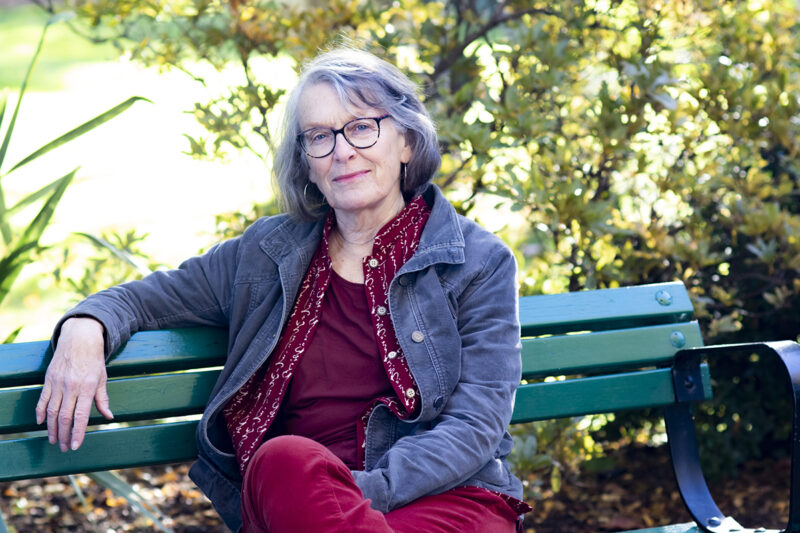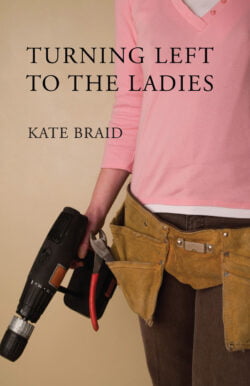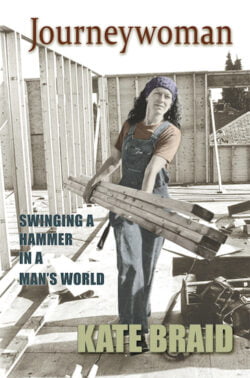#978 Crazy about lumber
Hammer & Nail: Notes of a Journeywoman
by Kate Braid
Halfmoon Bay: Caitlin Press, 2020
$22.95 / 9781773860336
Reviewed by Jennifer Chutter
*
 Kate Braid’s new memoir, Hammer & Nail: Notes of a Journeywoman, provides glimpses of her life as a carpenter, primarily in the Lower Mainland, during the 1970s and 1980s. Through a series of micro-essays she provides details of her working life, practical advice for women in trades, and feminist readings of male spaces. Taken in isolation the essays have little in common with each other, but Braid deftly threads herself throughout the narrative as a constant guide through rough yet rewarding terrain. Woven throughout the whole text is a beautiful love story where the reader gets hints and samples of Braid’s passion for her craft.
Kate Braid’s new memoir, Hammer & Nail: Notes of a Journeywoman, provides glimpses of her life as a carpenter, primarily in the Lower Mainland, during the 1970s and 1980s. Through a series of micro-essays she provides details of her working life, practical advice for women in trades, and feminist readings of male spaces. Taken in isolation the essays have little in common with each other, but Braid deftly threads herself throughout the narrative as a constant guide through rough yet rewarding terrain. Woven throughout the whole text is a beautiful love story where the reader gets hints and samples of Braid’s passion for her craft.
Braid shows how her daily writing life — which she began in the evenings to help process the job site and the unwritten codes among the men she worked with — led her to poetry. Her short bursts of thought after long and tiring days started to look like poems on the page. Some sections in the text are brief fragments of conversations, flashes of insight, or observations, while others are crafted essays that mirror the pattern of Braid’s working life, characterised by an intensity of work followed by lay off and explorations of different avenues.


Throughout these transitions, Braid’s poet soul led her to see the beauty in labour — the physicality of it, the value of creating something out of nothing, and the pride of returning to see a completed structure years later. She expands her ideas about the labouring body and its connection to the earth through construction to provide an astute commentary on current society’s disconnection caused by an over reliance on technology. In the process we have lost “touch with our physical selves — the smells and sounds and sights of the earth we walk upon” (p. 78). Braid sensually describes the smells, sounds of the work site, and materials. On one job site, she blurted out that, “Sometimes, I think I’m in love with wood. It’s why it took me so long to stick to one boyfriend. I’m too crazy about lumber” (p. 69). Braid captures the whine of the saw, the smell of the wood, and the sight of framed walls rising out of solid foundations. She creates a powerful sensorial reminder that love takes many forms and that we cannot escape our bodies.
Yet in the trades, male and female bodies are defined differently. Braid tackles these differences in two ways — through advice for women and by unpacking gender norms. First, Braid embeds practical advice for women in carpentry throughout Hammer & Nail, including what to wear, what to do with tampons, and how breasts, while a tangible marker of difference, do not need to be a woman’s defining feature on the job site. She includes practical advice on how to select tools and the importance and value of having tools that provide both the power needed for the job and comfort to smaller hand sizes.

Braid’s support for women includes ways of decoding male modes of discussion in order not to feel alienated in conversation. For example, she observes that “you don’t confess strong feelings, unless maybe it’s for a car, or a hockey team. You never talk about family, don’t breathe a word about kids” (p. 41) While she highlights the differences between how males and females conduct conversation, her aim is to understand a code, not to change conversation patterns to fit in or to suggest that one is superior to the other. Her advice includes how to respond to porn pin-ups in the common lunchroom and how to handle bullies: with sarcasm, an aptly timed joke, or a blunt “fuck off.” Ultimately, women should not attempt to shift, conform, or hide in order to become like men on the job site. Braid’s path was to accept differences and assert her place.
Second, she challenges stereotypical notions of femininity by showing how her muscles and sweat are a source of empowerment and strength. Joining the trades wasn’t about trying to be a man or to lose all femininity. It was about finding her voice, body, and place in a male-dominated profession. “In a world where every quality has been designated either male or female, why must I pick and choose? Why can’t I be both — both strong and tender, intelligent and emotional?” (p. 99) To answer this question, Braid thoughtfully challenges the gender norm that women don’t belong in the trades and considers the threats and fears that men hold about their traditionally male-dominated spaces being coopted in the name of equality. She illustrates the hidden strengths in women, specifically in asking for help, which she advocates not as a sign of weakness but as an openness and willingness to learn. The positive spinoff of asking for help is that it encourages men to do so as well, which ultimately improves job safety for everyone.

Braid’s examination of the Witch and Princess tropes becomes a way of reframing gender narratives. Men are not the enemy, and by truly listening to conversations, she discovered a rich inner emotional life hidden at work. This is not to suggest that things became easy once Braid figured out the codes of conduct; she still felt lonely, set apart, and often harassed. But it was through the job site that she came to a new understanding of gender. “As a girl, [she] was taught that if something hurt or was difficult, [she] should stop, or run to someone who could ‘fix it’” (p. 74). On the job site, however, leaving when something hurt, including feelings, meant a loss of a day’s pay and potentially not getting hired back, and while working through both physical and emotional pain, Braid “felt stronger, more confident, less vulnerable to hurt in the world at large” (p. 74).
Hammer & Nail is more than a memoir. It is a soft, delicate, and understated manifesto on living a good life. Find something you love to do. Be present in your body. Listen. Don’t make assumptions about another person’s gender. Stereotypes are restrictive. Listen some more. Ask questions. Be open to keep learning. Keep listening. Look for beauty in unlikely places. Live unapologetically.
*

Settler Jennifer Chutter is an award-winning PhD candidate at SFU. Her dissertation research is on the formation of the Strathcona Property Owners and Tenants Association (SPOTA) and how they advocated for their sense of home and place within in the neighbourhood. Their agency and activism bring to light the legacy of colonial structures within the city and emphasize the importance of preserving and designing neighbourhoods to foster a sense of belonging and inclusion. Her previous research was on the Vancouver Special and its importance as a localized form of architecture. She feels most at home in Vancouver when she smells the salty air while running along the seawall. Editor’s note: Jennifer Chutter has also reviewed books by Emma Fitzgerald, Iona Whishaw, Dave Doroghy & Graeme Menzies, T.K. (Justin) Ng, and Chelene Knight for The Ormsby Review.
*
The Ormsby Review. More Books. More Reviews. More Often.
Publisher and Editor: Richard Mackie
The Ormsby Review is a journal service for in-depth coverage of B.C. books and authors. The Advisory Board consists of Jean Barman, Robin Fisher, Cole Harris, Wade Davis, Hugh Johnston, Patricia Roy, David Stouck, and Graeme Wynn. Scholarly Patron: SFU Graduate Liberal Studies. Honorary Patron: Yosef Wosk. Provincial Government Patron since September 2018: Creative BC
“Only connect.” – E.M. Forster